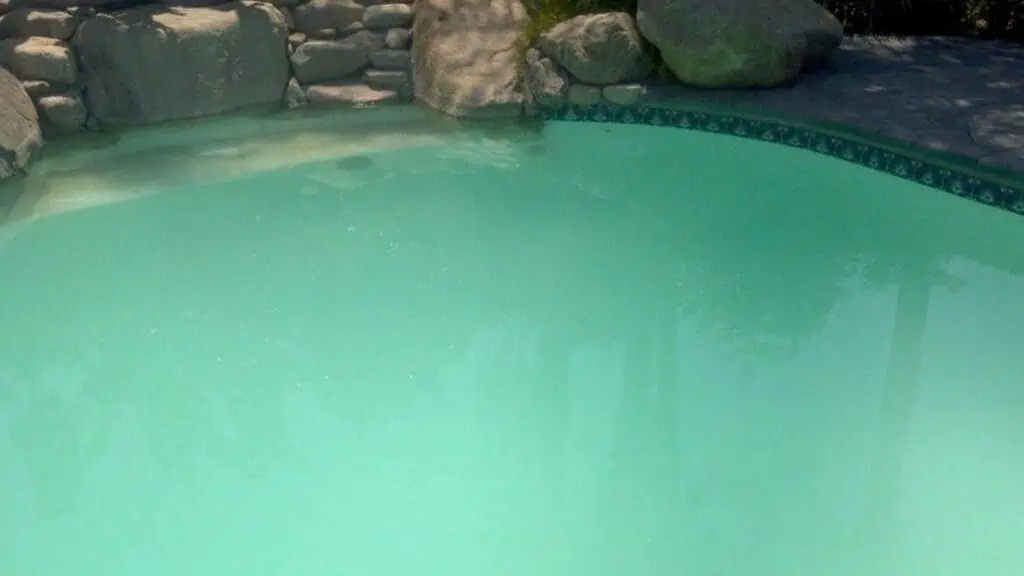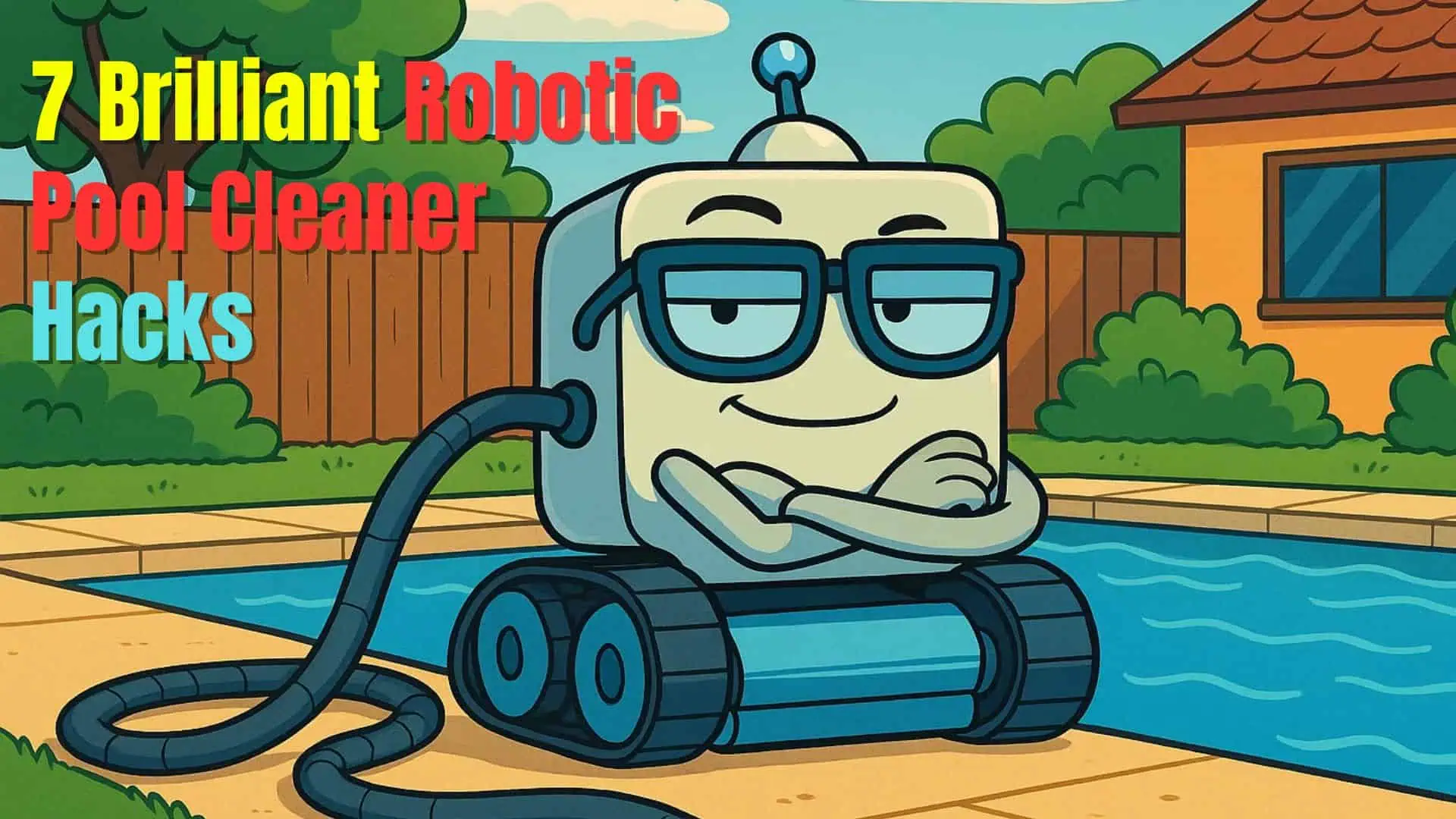Cloudy pool water looks uninviting and can indicate underlying issues with your pool maintenance. A swift response is essential to prevent further complications and restore your pool’s crystal-clear appearance.
In this article, we explore several steps to quickly clear cloudy pool water, address the root causes and recommend effective treatments.
Clearing the cloudiness in your pool can help maintain a pristine and enjoyable swimming environment for you and your guests.

How to Clear Cloudy Pool Water Fast
1. Check the Filtration
Proper filtration is essential for maintaining clear pool water.
Your pool will have one of three types of pool filter systems: a cartridge filter, a sand filter or a DE (Diatomaceous Earth) filter. It is vitally important that these filters are kept clean, either by removing and cleaning or replacing cartridge filters or backwashing sand or DE filters.
Cleaning and Replacing Cartridge Filters
Regular cleaning of your pool filter cartridges is crucial for optimal performance. A debris-filled filter cannot efficiently capture unwanted particles, causing cloudiness in your pool water. Y
ou can clean your filter cartridges by following these simple steps:
- Turn off the pool pump and remove the cartridges.
- Use a garden hose to rinse off dirt and debris from the cartridges.
- For deeper cleaning, consider using a filter-cleaning solution.
- Let the cartridges dry completely before reinstalling them.
Additionally, it’s important to replace your pool filter cartridges periodically. Their lifespan generally ranges from one to three years, depending on use and maintenance. A damaged or worn filter will not adequately filter particles, leading to cloudy pool water.
Backwash DE or Sand Filter
Backwashing is essential for maintaining clear water in pools with sand or diatomaceous earth (DE) filters. It involves reversing the water flow through the filter to remove dirt and debris accumulated over time. To perform the backwashing procedure, follow these steps:
- Turn off the pool pump.
- Adjust the filter valve to the “backwash” setting.
- Turn on the pump and let it run until the waste water appears clear (typically 2-3 minutes).
- Turn off the pump and set the valve back to its normal setting.
- Resume normal operation of the pool pump.
Backwashing should be done periodically, depending on your filter’s pressure gauge and manufacturer’s recommendations. This can significantly enhance the efficiency of your filtration system and contribute to maintaining clear pool water.
2. Balancing Pool Chemistry
Maintaining balanced pool chemistry is crucial to quickly clearing cloudy pool water. You do this by testing the water’s chemical levels and adjusting them to achieve a crystal-clear pool.
Testing Water Parameters
Regularly testing your pool water is essential for maintaining the right balance of chemicals.
It is recommended to test at least once a week, or more frequently if you experience issues with cloudy water. When testing, pay attention to the following parameters:
- pH levels: Aim for a pH between 7.4 and 7.6. A level outside this range might lead to cloudy water and interfere with the effectiveness of sanitizers.
- Alkalinity: Ensure your total alkalinity is between 80 and 120 ppm to help stabilize pH levels and prevent fluctuations.
- Calcium hardness: Aim to maintain calcium hardness between 200 and 400 ppm in concrete pools, and 175 to 225 ppm in vinyl pools.
- Chlorine: To effectively sanitize your pool and eliminate contaminants, keep your free chlorine levels between 1 and 3 ppm.
I suggest you buy test strips that cover all aspects of your water quality, not just pH, chlorine and alkalinity.
Recommended Test Strips
Adjusting Chemical Levels
After testing the water parameters, it’s time to adjust the chemical levels accordingly. Here’s how:
1. Add sodium bicarbonate to raise pH levels. If you need to lower the pH, use muriatic acid or sodium bisulfate.
2. If alkalinity is too low, add sodium bicarbonate to increase it. To decrease alkalinity, use muriatic acid or sodium bisulfate.
3. If calcium hardness is low, calcium chloride can be added to raise it. Reducing calcium hardness is more complicated and may require partially draining and refilling your pool with fresh water.
4. Add more sanitizer, such as liquid or granular chlorine, to raise chlorine levels. If the chlorine levels are too high, you can either wait for them to naturally decrease over time or reduce the amount of sanitizer added to the pool.
Cloudy pool water can be resolved quickly by balancing your pool chemistry and closely monitoring the water parameters. This will help you maintain a clean and safe swimming environment.
Use Pool Clarifiers and Flocculants
Once the above have all been checked, cleaned or adjusted, you can quickly and effectively use pool clarifiers and flocculants to clear cloudy pool water.
Choosing the Right Product
Both clarifiers and flocculants effectively treat cloudy pool water, but they work in slightly different ways.
Clarifiers are designed to group tiny particles, making it easier for your filter to remove them from the water. In my experience, the Clorox Pool&Spa Crazy Clarifier works quickly.
Flocculants (or “pool floc”) cause particles to settle at the bottom of the pool, where they can be vacuumed out. Doheny’s Extra-Strength Pool Flocculant is very effective.
If your filter is working well and the issue is simply that the particles are too small to capture, then a clarifier is likely the best option.
A flocculant might be better if your pool water is consistently cloudy regardless of filtration.
Application Tips
Follow these tips when applying clarifiers or flocculants to your pool:
- Follow manufacturer instructions: Different products have varying application rates and methods. Carefully read and follow the instructions on the product packaging to ensure the best results.
- Turn off the pump: When using a flocculant, turn off your pool pump and allow the water to become still. This helps the particles settle more effectively at the bottom of the pool.
- Vacuum thoroughly: After applying a flocculant, use a pool vacuum cleaner to remove the settled debris from the bottom of the pool. Be sure to vacuum slowly and carefully to ensure all debris is removed.
- Monitor filter pressure: When using a clarifier, check the filter pressure gauge. If the pressure rises too high, backwash or clean the filter as needed.
By correctly utilizing pool clarifiers and flocculants, you can make your pool water crystal-clear and inviting again.
Identifying the Cause of Cloudy Pool Water
Before you can effectively clear your cloudy pool water, it’s essential to identify the root cause. If you just attack the symptoms without rectifying the cause, then you are likely to soon have a cloudy pool again.
This section will briefly discuss some common causes, which can be grouped into three key categories: poor filtration, chemical imbalance, and environmental factors.
Poor Filtration
A faulty or clogged filter can lead to cloudy pool water. Proper filtration helps in maintaining water clarity by removing particles and debris. To ensure good filtration:
- Check your filter for worn or broken parts and replace them if necessary.
- Run the pump for at least 8 hours a day.
- Backwash the filter until a clear stream of water flows.
- Chemically clean your filter media with a filter cleaner if needed.
Chemical Imbalance
Imbalanced water chemistry can lead to cloudy pool water and skin and eye irritation for swimmers. Common imbalances include:
- Improper levels of chlorine
- Imbalanced pH and alkalinity levels
- Very high calcium hardness (CH) levels
- Ammonia
Correcting these imbalances by regularly testing and adjusting your pool chemicals is crucial for maintaining water clarity.
Environmental Factors
Environmental factors like debris, algae growth, and contamination can cause cloudy pool water. To minimize these issues:
- Regularly clean your skimmers and use a net to remove leaves and debris.
- Address early stages of algae growth, which can cause water to become cloudy.
- Vacuum and scrub the pool floor and walls to remove dirt and algae buildup.
- Ensure proper water circulation by positioning your pool returns correctly.
Preventing Future Cloudiness
Now that you’ve successfully cleared your cloudy pool water, preventing it from happening again is important. The two key aspects of pool maintenance that will help you avoid future cloudiness are:
Regular Maintenance
Regular maintenance is essential for keeping your pool water clear and contaminants-free. Some maintenance tasks to incorporate into your routine include:
- Testing the water balance regularly and adjusting chemical levels as needed
- Cleaning the pool filter and replacing it if necessary
- Brushing and vacuuming the pool walls and floor to remove dirt and debris
- Using a pool skimmer to remove floating debris from the water surface
By staying on top of these tasks, you’ll reduce the likelihood of cloudy water and maintain a healthy swimming environment.
Covering the Pool
Covering your pool when it’s not in use can help prevent cloudiness in several ways:
- It reduces the amount of debris and dirt entering the pool
- It minimizes water evaporation, which can cause chemical imbalances
- It helps prevent algae growth by blocking sunlight
In addition to these benefits, a pool cover also helps conserve water and maintain consistent water temperature, making your pool more enjoyable. Make sure to clean and maintain your pool cover regularly, as a dirty or damaged cover can become a source of contamination itself.
FAQs
Can shocking the pool help clear cloudiness?
Shocking the pool can help by breaking down organic contaminants, improving sanitizer efficiency, and eliminating algae, which can contribute to cloudiness.
Does pool usage affect cloudiness?
Yes, heavy pool usage can introduce contaminants, such as oils and lotions, which can lead to cloudiness. Regular cleaning and proper water chemistry management can help minimize the impact.
How long does it take for a cloudy pool to clear?
The time required to clear a cloudy pool depends on the severity of the issue and the treatment methods used. Proper treatment can take anywhere from a few hours to several days for the water to clear.
Can a damaged pool filter cause cloudiness?
A damaged or improperly functioning pool filter can cause cloudiness. If the filter is not working efficiently, it may be unable to remove small particles, leading to cloudy water. Check the filter for any signs of wear, damage, or clogging, and clean or replace the filter media as needed.









Leave a Reply